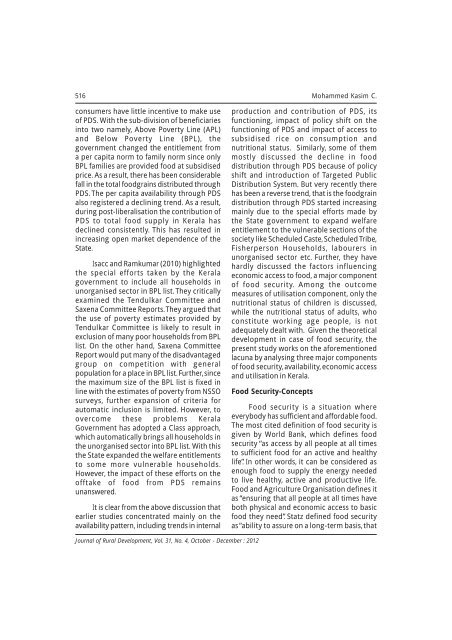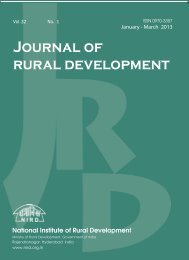October - December 2012 - National Institute of Rural Development
October - December 2012 - National Institute of Rural Development
October - December 2012 - National Institute of Rural Development
- No tags were found...
You also want an ePaper? Increase the reach of your titles
YUMPU automatically turns print PDFs into web optimized ePapers that Google loves.
516 Mohammed Kasim C.consumers have little incentive to make use<strong>of</strong> PDS. With the sub-division <strong>of</strong> beneficiariesinto two namely, Above Poverty Line (APL)and Below Poverty Line (BPL), thegovernment changed the entitlement froma per capita norm to family norm since onlyBPL families are provided food at subsidisedprice. As a result, there has been considerablefall in the total foodgrains distributed throughPDS. The per capita availability through PDSalso registered a declining trend. As a result,during post-liberalisation the contribution <strong>of</strong>PDS to total food supply in Kerala hasdeclined consistently. This has resulted inincreasing open market dependence <strong>of</strong> theState.Isacc and Ramkumar (2010) highlightedthe special efforts taken by the Keralagovernment to include all households inunorganised sector in BPL list. They criticallyexamined the Tendulkar Committee andSaxena Committee Reports. They argued thatthe use <strong>of</strong> poverty estimates provided byTendulkar Committee is likely to result inexclusion <strong>of</strong> many poor households from BPLlist. On the other hand, Saxena CommitteeReport would put many <strong>of</strong> the disadvantagedgroup on competition with generalpopulation for a place in BPL list. Further, sincethe maximum size <strong>of</strong> the BPL list is fixed inline with the estimates <strong>of</strong> poverty from NSSOsurveys, further expansion <strong>of</strong> criteria forautomatic inclusion is limited. However, toovercome these problems KeralaGovernment has adopted a Class approach,which automatically brings all households inthe unorganised sector into BPL list. With thisthe State expanded the welfare entitlementsto some more vulnerable households.However, the impact <strong>of</strong> these efforts on the<strong>of</strong>ftake <strong>of</strong> food from PDS remainsunanswered.It is clear from the above discussion thatearlier studies concentrated mainly on theavailability pattern, including trends in internalproduction and contribution <strong>of</strong> PDS, itsfunctioning, impact <strong>of</strong> policy shift on thefunctioning <strong>of</strong> PDS and impact <strong>of</strong> access tosubsidised rice on consumption andnutritional status. Similarly, some <strong>of</strong> themmostly discussed the decline in fooddistribution through PDS because <strong>of</strong> policyshift and introduction <strong>of</strong> Targeted PublicDistribution System. But very recently therehas been a reverse trend, that is the foodgraindistribution through PDS started increasingmainly due to the special efforts made bythe State government to expand welfareentitlement to the vulnerable sections <strong>of</strong> thesociety like Scheduled Caste, Scheduled Tribe,Fisherperson Households, labourers inunorganised sector etc. Further, they havehardly discussed the factors influencingeconomic access to food, a major component<strong>of</strong> food security. Among the outcomemeasures <strong>of</strong> utilisation component, only thenutritional status <strong>of</strong> children is discussed,while the nutritional status <strong>of</strong> adults, whoconstitute working age people, is notadequately dealt with. Given the theoreticaldevelopment in case <strong>of</strong> food security, thepresent study works on the aforementionedlacuna by analysing three major components<strong>of</strong> food security, availability, economic accessand utilisation in Kerala.Food Security-ConceptsFood security is a situation whereeverybody has sufficient and affordable food.The most cited definition <strong>of</strong> food security isgiven by World Bank, which defines foodsecurity “as access by all people at all timesto sufficient food for an active and healthylife”. In other words, it can be considered asenough food to supply the energy neededto live healthy, active and productive life.Food and Agriculture Organisation defines itas “ensuring that all people at all times haveboth physical and economic access to basicfood they need”. Statz defined food securityas “ability to assure on a long-term basis, thatJournal <strong>of</strong> <strong>Rural</strong> <strong>Development</strong>, Vol. 31, No. 4, <strong>October</strong> - <strong>December</strong> : <strong>2012</strong>

















